

Site Search
Search within product
第738号 2022 (R04) .02-03発行
Click here for PDF version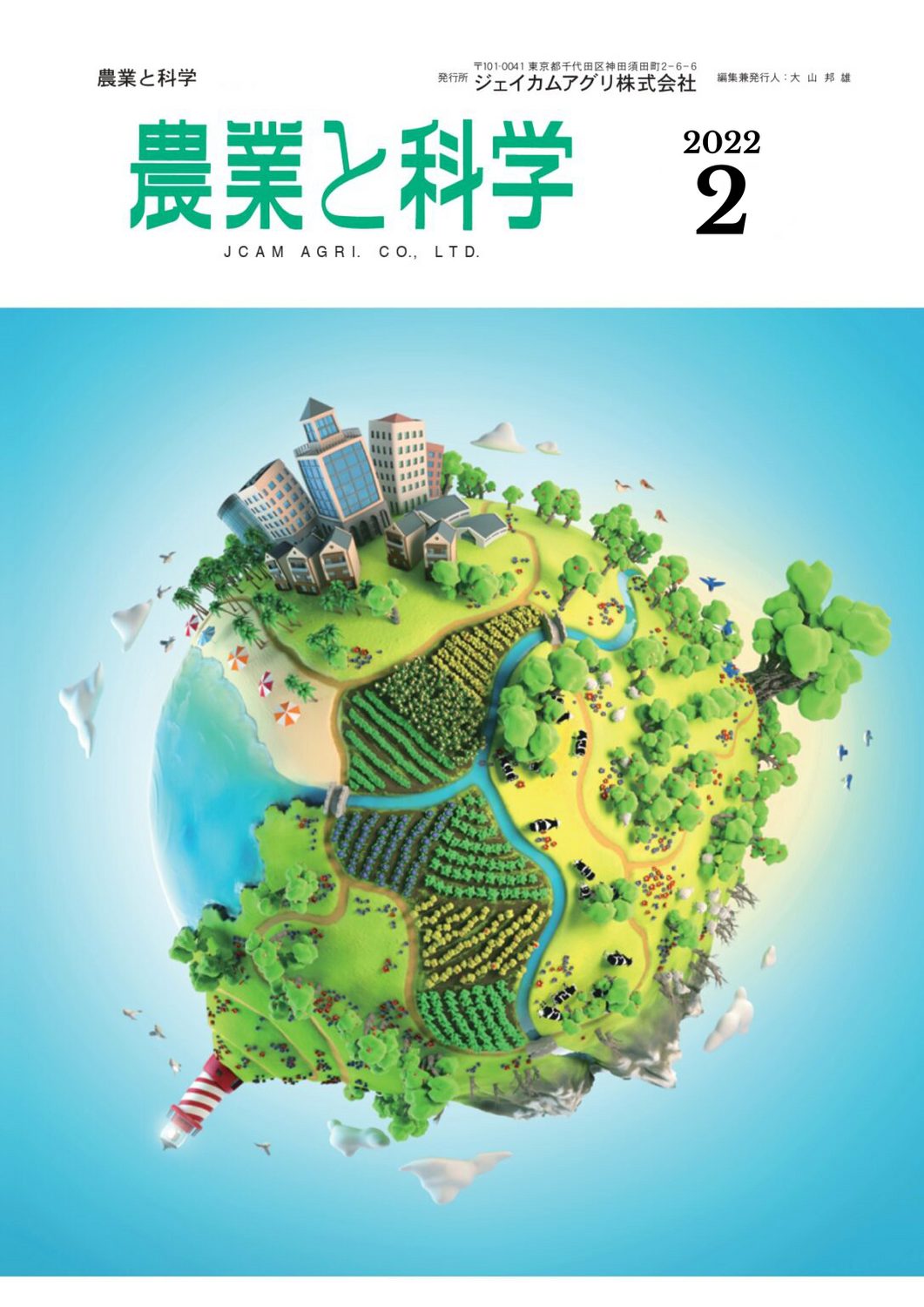
農業と科学 令和4年2-3月
本号の内容
§Experience high-yield technology using a combination of side-row fertilizer application and seedling box placement.
Jcam Agri Corporation Tohoku Branch
技術顧問 上野 正夫
No § Soil - No. 9
よい土の条件 化学的性質−その4
土が養分を保持するしくみ
Jcam Agri Co.
北海道支店 技術顧問
松中 照夫
Experiencing high-yield technology using a combination of side-row fertilizer application and seedling box placement
Jcam Agri Corporation Tohoku Branch
技術顧問 上野 正夫
Introduction.
苗箱まかせは苗箱内での窒素の初期溶出を極力抑制することにより肥料による障害を全く受けず,良質苗が生産され,それを移植することで本田施肥も賄える究極的省力低コスト施肥技術として脚光を浴びてきました。一方,苗箱まかせによる本田溶出はどうしても初期が緩慢で,乾土効果による窒素発現量の多い肥沃な土壌では,初期生育が適度に確保されますが,低地力土壌ではどうしても初期生育が不足気味になります。現在,苗箱まかせの対照相手として全量基肥一発施肥を考えた場合,生育初期は全量基肥施肥技術が優り,生育後期は苗箱まかせが優位にあると考えます。
Therefore, when considering high-yield technology based on seedling box-assisted fertilization, it is natural to assume that combining side-row fertilization, which ensures early growth, with seedling box-assisted fertilization, which is good at late leaching, is a reasonable high-yield technology. Here, we introduce the basic concept of high-yield technology and a local high-yield technology that combines side-row fertilizer application and seedling box-applied fertilizer.
Seedling technology using seedling boxes
(High nitrogen quality seedlings are produced by pooled seedling cultivation and box-bottom fertilization, which is left up to the seedling box).
There are three ways to use box-makase: mixed application of bedding soil and box-makase, layered application, and box-bottom application. The author recommends box-bottom fertilization. Consider the area around the seed rice when seedling seed roots begin to grow. As shown in Figure 1, in the case of layered fertilization, the seeds and the seedling box are living together. In contrast, in box-bottom fertilization, the seed is sandwiched between the bedding soil and the covering soil because the seedling box is at the bottom of the box. This results in a difference in moisture retention. After the seedlings are ready to sprout, lack of moisture can be fatal to the seedlings. It is important to use a bedding medium with high water retention capacity and to apply fertilizer at the bottom of the seedling box. This does not negate the need for layered fertilization. The solution is to pay close attention to irrigation.

Pool irrigation (Photo 1) is recommended. The most important thing for box-grown seedlings is to achieve uniform germination length. The most important thing for box-raised seedlings is to keep the emergence length as short as possible. The budding length should be kept strictly within 0.5 to 1 cm. Long sprouting length is "a hundred harms and not a hundred good". Once the seedlings have sprouted, use pooled seedlings and imagine the conditions of a water nursery. It is acceptable to stop watering after one day, depending on the condition of the pool-grown seedlings, and irrigate again after 2 to 3 days, and it is good if the seedlings stay under water after 1 to 1.5 leaves. If the water temperature rises abnormally after Golden Week, it is necessary to change the water. Water should be removed 2 to 3 days prior to rice planting. As we have pointed out many times in the past, seedlings grown in a seedling box are prone to water shortage because the amount of soil is reduced by the amount of fertilizer applied to the seedlings. Pool irrigation is the best way to solve this problem. Again, it is important to keep the seedlings in a "waterlogged nursery" to prevent water shortage after seedling emergence. This is why we recommend pooled irrigation.
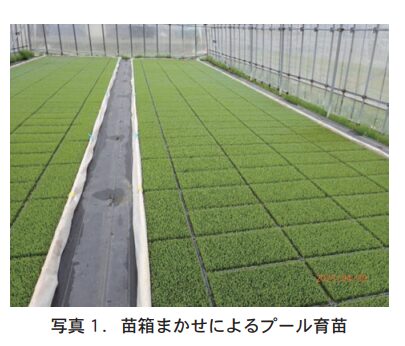
Another important thing is to control seedling elongation after the budding stage in the case of greenhouse seedling production. This means controlling the length of emergence, the height of the first leaf sheath, and the height of the second leaf sheath. To achieve this, the temperature inside the greenhouse should not be increased. Open the greenhouse first thing in the morning except in the event of low temperatures, rainfall, or strong winds. Furthermore, if the temperature rises, we aim to open the greenhouse to its full extent. The key is to keep the temperature inside the greenhouse at a moderate level, and to keep the greenhouse at 1.5 leaves, which is too short for the seedlings to grow. In the latter half of seedling growth, about 2% of the nitrogen in the seedling box is leached out. This ensures good quality seedlings with high nitrogen content, or "Zunguri" seedlings.
2. dry-soil effect on early growth of paddy rice
The amount of nitrogen in paddy soils is rooted in degradable organic nitrogen (N0), which is present at about 10% of total soil nitrogen, and can be broken down into a dry-soil effect-derived fraction (N0q) and a soil temperature increase-derived fraction (N0s). The dry-soil effect-derived fraction is mostly expressed from the end of May to the beginning of June. Therefore, its quantity greatly affects the early growth of paddy rice plants. As we have pointed out in the past, the initial leaching of nitrogen from the seedling box is slow and reaches its maximum amount in mid to late July in rice fields where the seedlings are left to grow in the box. Therefore, if only seedlings are transplanted from the seedling box, nitrogen leaching in the early stage of the field will be insufficient, making it difficult to obtain the initial number of stems. The combined amount of fast-acting fertilizer at transplanting and soil nitrogen due to the dry-soil effect will control the initial growth of the seedlings.
In order to expect a dry-soil effect, the amount of soil fraction derived from the dry-soil effect is of course important, but it also depends on how much air-dried soil mass is increased in early spring, between tillage and plowing. Plowing should be done as early as possible to increase the proportion of white-dry clods. No matter how large the fraction of soil derived from the dry-soil effect may be, the dry-soil effect cannot be expected if the soil is plowed in late, watered immediately after plowing, and raked immediately after tillage. In other words, rice plants can maintain good nitrogen nutrition conditions throughout their growth by relying on side-row fertilization and soil nitrogen derived from the dry-soil effect in the early stage of rice growth, and relying on soil nitrogen derived from seedling box placement and soil temperature increase effect in the middle and late stages of growth.
The effects of tillering time and dry soil on soil nitrogen expression and initial stem number are shown in Figure 2. The soil nitrogen content at 6/9, one month after transplanting, and the number of stems at that time are shown in Table 1. In other words, as mentioned above, if tillage is delayed and watering and raking are done immediately after tillage, no dry-soil effect can be expected. In order to expect a dry soil effect, it is effective to accelerate the tillage period and accelerate the drying of the soil surface layer before watering and raking.
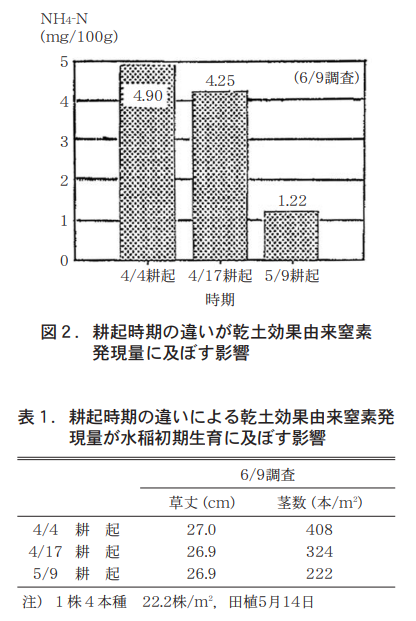
3.適正籾数(36,000粒/㎡)を確保する生育パターン
多収を達成するためには,適正籾数をどのように確保し,登熟歩合をいかに高めるかにかかっております。600kgの収量を得るには,32,000粒/㎡程度の籾数が必要になります。720kgの多収穫を得るためには,36,000粒/㎡程度の籾数が必要となります。こうした適正籾数を確保して,千粒重23.0g,登熟歩合86%を達成できれば多収穫が完成です。文字で書けば簡単ですが,そう簡単ではありません。農家はどのような稲を作れば,適正籾数が確保できるか常に考えています。まさに腕の見せ所になります。
Based on many years of experience, the author has been aiming for high yield with ear-weighted varieties such as Sasanishiki and Koshihikari by increasing the rate of rice maturity (V-shaped rice cultivation) by reducing leaf color in the middle stage of growth to prevent collapse and by limiting the number of paddy per ear without overgrowing the maximum number of stems, although early growth is important. On the other hand, recent high-yielding varieties have been dominated by short, ear-heavy varieties (Haenuki, Setsuwakamaru, etc.), which are more resistant to downfall. These varieties are particularly important for early growth, and the aim is to grow rice with a sense of ear weight by not losing much leaf color in the middle stage of growth (heji-shape rice cultivation) and by thickening the stem mainly through deep water management, etc., with the parent stem as the main body. In other words, there is a growing trend toward high-yield rice cultivation that emphasizes late-season nitrogen nutrition by securing initial stem number with fast-acting fertilizers such as side-row fertilization and maintaining leaf color from the mid-seedling stage onward by leaving the seedlings to the seedling box. The combination of side-row fertilizer application and leaving it to the seedling box is exactly what is expected.
4. proper nitrogen uptake pattern and late stage nitrogen nutrition
It is important to clarify the relationship between nitrogen absorption patterns of paddy rice and brown rice yield in order to secure an appropriate number of rice grains. Here, we will examine the process of nitrogen absorption in high-yield rice paddies in the Shonai region of Yamagata Prefecture. The Shonai area is one of the best rice-producing regions in Japan, and for more than 40 years, a rice-growing campaign has been conducted in the area, with 60 demonstration fields established at each of the agricultural cooperative branches. Among them, 14 demonstration fields with different yield levels were selected and nitrogen absorption by rice plants was investigated at different times of the year over a two-year period. Figure 3 shows the results of the survey of the demonstration fields and the relationship between nitrogen absorption and brown rice yield since 1965 from the three-factor test conducted at the Shonai Branch.
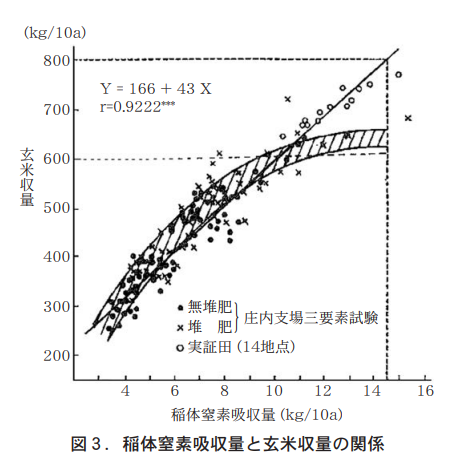
According to the data from the three-factor test, there was a linear positive relationship between brown rice yield and nitrogen absorption up to a brown rice yield of about 600 kg per 10 a, as has been pointed out in the past, and a tendency for nitrogen absorption to slow down at higher yields. However, when the absorbed amount of nitrogen in the 14 demonstration fields where soil improvement was emphasized was added, the linear positive relationship between brown rice yield and nitrogen absorption continued up to about 800 kg per 10 a. This is because soil improvement in the demonstration fields has an effect on nitrogen uptake. This was attributed to the effect of soil improvement in the demonstration fields, especially the application of siliceous fertilizers based on soil diagnosis, which stabilized the maturity yield and led to stable yield even when nitrogen absorption increased, thus establishing the above-mentioned relationship.
Next, the yields of the demonstration fields (14 locations) were divided into two groups: the 700 kg/10 a level (average 727 kg at 7 points) and the 600 kg/10 a level (average 667 kg at 7 points), and the percentage of nitrogen absorption at each time is shown in Table 2. According to the results, the 700 kg/10 a level group absorbed more nitrogen than the 600 kg/10 a level group, and in the nitrogen absorption ratio by time, the amount of nitrogen absorbed after the ear-arrangement period was higher, which is a major characteristic of autumn-successive growth. This is what we expect from the seedling box.
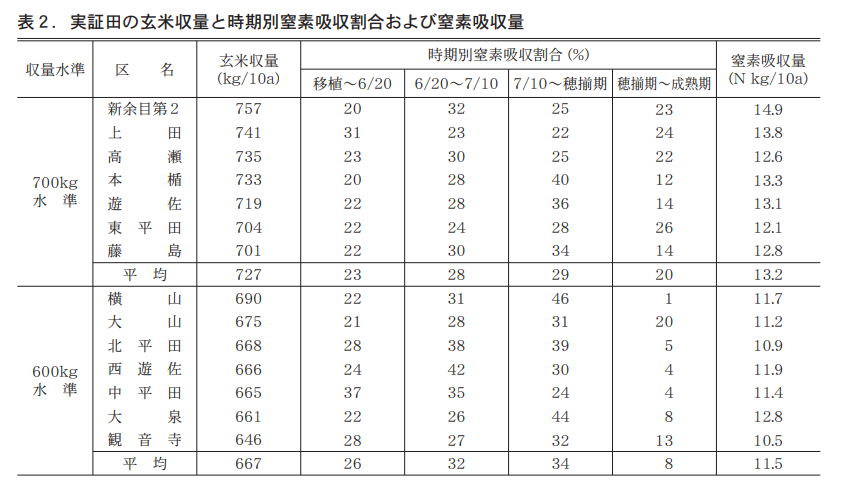
Demonstrated high yield with 1:1 side-row fertilization and seedling box application for total nitrogen
The Hondate area of Sakata City is located in the center of the Shonai-Atsumi district and has a reputation for being a representative area of high-quality rice production. In this area, three young farmers were asked to set up a test plot with a total of 8 kg/10a (4 kg/10a of side-row fertilizer and 4 kg/10a of seedling box compost) over a period of two to three years from 2020, and conducted a demonstration test using farmer's practice (base fertilizer + additional fertilizer) as a control. This test was conducted in collaboration with Farm Frontier Corporation (Dr. Fujii) as part of the "Smart Agriculture: Soil Preparation Linked Next-Generation One-Shot Basal Fertilizer System. The three young farmers were asked to use the "seedling box leave" system for the first time, and they had no problems and obtained good quality seedlings with high nitrogen and slimy seedlings. The seedlings were grown in 25 boxes of N400-100 at 400 g/box per 10 a. The variety was "Haenuki". The variety "Haenuki" was used.
Table 3 shows the results of the yield survey conducted in 2020, the first year of the study. According to the results, in each test site, the initial growth tended to be superior to that of the control site (farmer's practice) when side-row fertilizer was applied, and the side-row + seedling box area showed a clear trend toward higher stem quality (culm) and less variation in culm quality, and yield increased by 2 to 14% compared to the control area, achieving a yield of almost 700kg/10a.
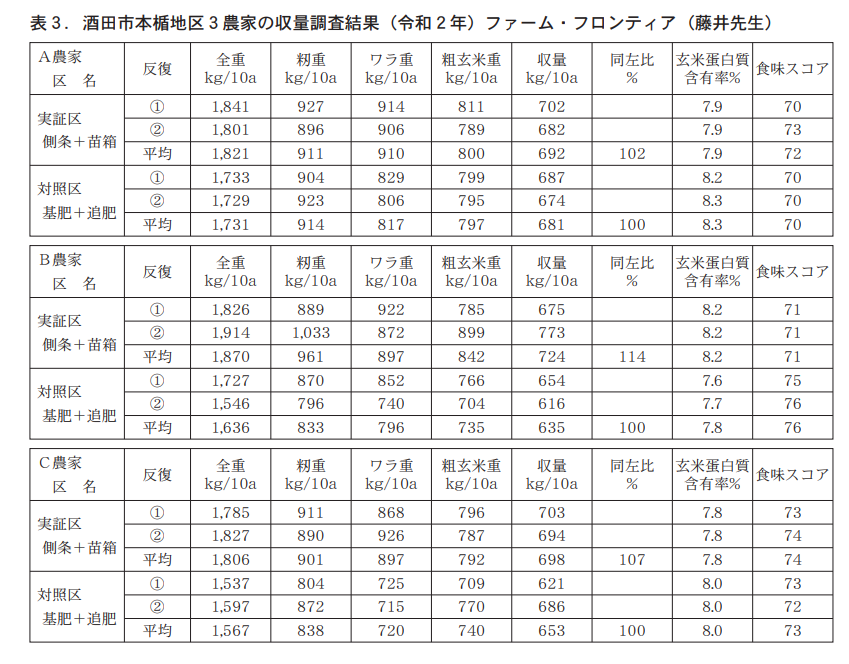
6. Conclusion
側条施肥と苗箱まかせの相性の良さが明らかになりました。全窒素施肥量を8kg/10aで考えると,側条施肥と苗箱まかせの施肥窒素の割合は1:1が適当であると現地試験で実証されましたが,その割合は土壌肥沃度によって変更して差し支えないと考えます。また,側条施肥機がない場合は,速効性肥料(例えばオール14 1〜2袋等)を移植前に圃場全面に施肥しておいても同様と考えます。つまり,水稲の初期生育を土壌窒素(乾土効果)と速効性肥料の合量に依存し,中後期の窒素栄養を苗箱まかせと土壌窒素(地温上昇効果由来窒素)で補給することで生育全般にわたり継続した窒素栄養をもたらすことで高収量に結びつくものと考えます。また,苗箱まかせは窒素のみ(NK301は窒素と加里)で側条施肥や速効性肥料を併用することでリン酸,加里も同時に補給されます。あとは,自分が経験してきた技術を駆使し,磨き上げてきた技術で,適正籾数(36,000粒/㎡)を安定的に確保できるかが多収穫のカギとなります。
土のはなし−第9回
よい土の条件 化学的性質−その4
土が養分を保持するしくみ
Jcam Agri Co.
北海道支店 技術顧問
松中 照夫
It is hard to believe that soil is electrostatically charged. However, because of this property of soil, nutrients contained in fertilizers and compost are attracted to and retained in the soil by electrostatic forces. Those who discovered the soil's ability to hold these nutrients (nutrient retention capacity) must have been surprised, too.
1. discovery of nutrient retention capacity of soil
The story goes back to England about 170 years ago. At that time, chemical fertilizers were new to the world and were rarely used. Therefore, the source of nutrients for crops depended exclusively on compost produced from livestock manure. However, the ammonia contained in the manure would volatilize and lose if left unattended. To prevent this, sulfuric acid, a byproduct of coal combustion, was diluted and spread on the compost heap.
However, the sulfuric acid treatment resulted in the production of large amounts of ammonium sulfate. Thompson, a wealthy farmer in Yorkshire, northern England, wondered if the sulfuric acid treatment would actually reduce the fertilizing effect of the compost because rainwater would dissolve the ammonium sulfate and run off into the ground. Thompson asked Spence, a pharmacist with a background in chemistry, to test the veracity of his suspicions.
スペンスは農場の土に硫酸アンモニウムを与えてよく混ぜ,それをガラス管に詰めて上から蒸留水(H2O)を流し,下から出てきた浸透水の成分を分析した。すると,添加したはずのアンモニウムが浸透水から消え,代わりにカルシウムが硫酸カルシウムとなって現れた。このスペンスの実験結果から,トンプソンは土がアンモニウムをひきつけて保持したと考え,世界で最初にこの事実を論文発表した。1850年のことである。
Around the same time, Huxtable of Dorset, southern England, also recognized the ability of soil to purify the color and odor-causing substances in manure mixtures.
After hearing the results of these experiments at a meeting of the Royal Agricultural Society of England, Ouray followed up their experiments himself and reaffirmed that the results were true. Later, after five years of extensive experimentation, he found that the clay of the soil had the ability to attract substances. The paper by Ouray describing these findings appeared in the same issue of the same journal in which Thompson's paper appeared, but on a page behind Thompson's.
All of them, who were interested in similar phenomena in the same period, concluded that this property of the soil would play a major role in actual agriculture. Among them, Ouray even believed that this soil property was due to ion exchange occurring in the soil. However, it was not until some 40 years after his death that this idea was accepted by the public.
2. the carrier of the soil's nutrient retention capacity
The results of Wei's experiments led to research on soil organic matter and clay minerals and their ability to retain nutrients, which were found to have electrically charged properties. It was found that soils can be negatively electrically charged (negative charge) or positively electrically charged (positive charge) in some cases.
(1) Bearer of soil load (negative electricity)
土の負荷電の担い手は,①粘土鉱物の構造変化による荷電,②粘土鉱物の端末にできる荷電,③有機物(腐植)の端末にできる荷電の3つである。粘土鉱物とは土の原料である岩石(一次鉱物)が物理的,あるいは化学的な風化作用をうけて変成し,元の岩石とはちがう鉱物(二次鉱物)となったものである。基本となる構造はケイ素もしくはアルミニウムが主体となり,それに酸素,水素などが規則性をもって結合した1枚の面状になっている。ここではケイ素主体のシート,アルミニウム主体のシートということにする。負荷電の担い手の①は,この粘土鉱物の結晶,たとえばケイ素主体のシートで,ケイ素(プラスの電気を帯びる手(正荷電)の数が4つ)が,原子の大きさがほぼ同じのアルミニウム(正荷電の数が3つ)と入れ替わる(同型置換という)ことによってできる(図1)。
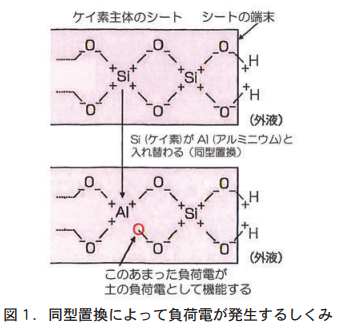
The four positively charged silicon is balanced by the four positively charged oxygen. However, when it is replaced by aluminum, which has three positive charges, there is a surplus of one loading charge of oxygen. This excess charge is a stable charge that always functions as a loading charge regardless of the surrounding conditions, and is called a permanent charge.
負荷電の担い手の②と③は,いずれも荷電の周りのpHが上がるとともに発生する。pHが上がるというのは,水素イオン(H⁺)が減少して水酸イオン(OH⁻)が増えることを意味している。②の場合も③の場合も,粘土鉱物のシートや有機物の端末にある水酸基(−OH)やカルボキシル基(−COOH)の端にある水素(H)が,増えた水酸イオンにひき寄せられ,結合している酸素(O)からひきはがされてH2Oをつくることで負荷電に余剰が発生し,土の負荷電として機能する(図2) 。つまり,この負荷電はpHの影響を受けて変化する不安定な荷電で,変異荷電という。
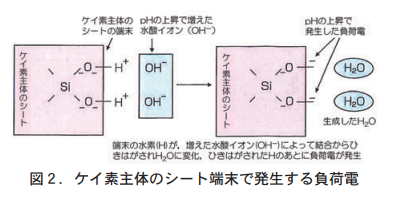
(2) Bearer of positive charge (positive electricity)
土の正荷電の担い手は,①アルミニウム主体のシートの端末にできる荷電,②有機物の端末にできる荷電,③風化が進んだ土の粘土鉱物(鉄やアルミニウムの酸化物)にできる荷電の3つである。これら3つの荷電はいずれも周りのpHが下がるとともに発生する変異荷電である。pHが下がるということは水素イオン(H⁺)が増えることを意味している。正荷電が発生する基本的なしくみは,①②③のいずれも同じで,それぞれの端末にある水酸基(−OH)やカルボキシル基(−COOH)などがpH低下で増えた水素イオン(H⁺)をひき寄せてオキソニウムイオン(−OH2⁺)をつくり,これが正荷電として機能する(図3)。
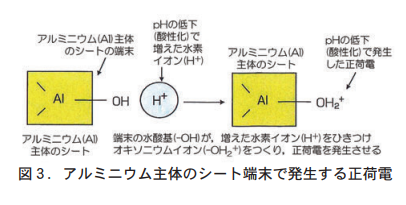
3. permanent charge and exchangeable aluminum
先に指摘した永久荷電の負荷電はpHの影響を受けない。このため,酸性化してpHが低下しても負荷電として機能しているので,酸性条件で現れるアルミニウムイオン(Al3⁺)を交換性陽イオンとして安定して保持できる。本連載第7回で紹介した非アロフェン質黒ボク土はこのタイプの負荷電を持っており,作物の酸性障害の原因となる交換性アルミニウムを多く保持できた。トウモロコシに酸性障害が発生したのはこのためである。
On the other hand, allophenic black box soils are predominantly mutagenically charged from organic matter and become positively charged upon acidification. Exchangeable aluminum, which has the same positive charge, repels the positive charge of the soil and cannot exist stably. Therefore, it can be understood that the allophenolic black box soil did not cause acid damage to the corn. This is a very interesting phenomenon.